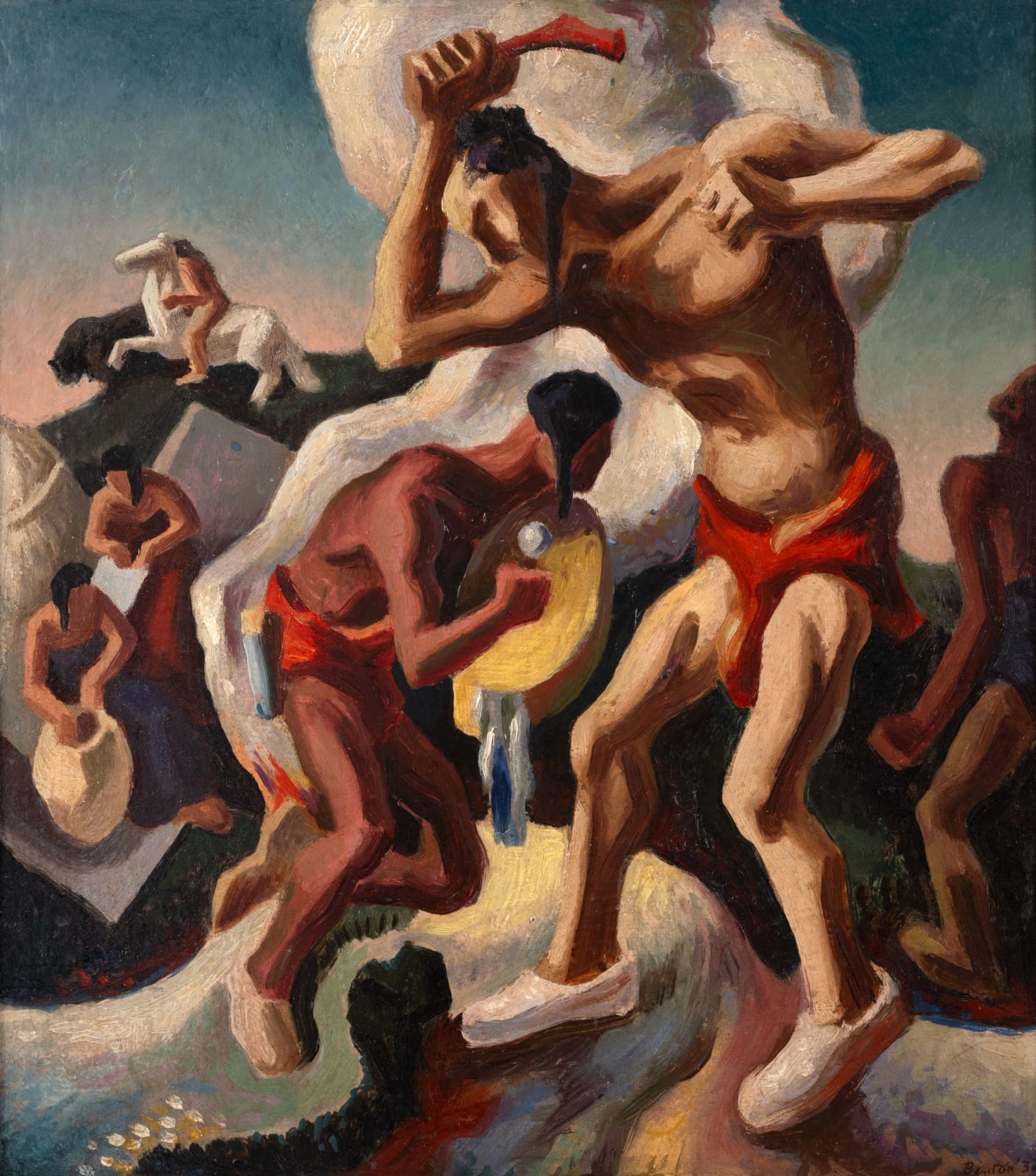-
Thomas Hart Benton 1889-1975
Study for "The Arts of Life in America: Indian Arts", 1932Oil on board18 x 15½ inches
45.7 x 39.4 cmSigned and dated at lower right: Benton '32This work will be included in the forthcoming catalogue raisonné being prepared by the Thomas Hart Benton Catalogue Raisonné Foundation. Committee Members: Dr. Henry Adams, Anthony Benton Gude, Andrew Thompson...This work will be included in the forthcoming catalogue raisonné being prepared by the Thomas Hart Benton Catalogue Raisonné Foundation. Committee Members: Dr. Henry Adams, Anthony Benton Gude, Andrew Thompson and Michael Owen.
Study for The Arts of Life in America: Indian Arts serves as an entry point into Thomas Hart Benton's ambitious mural series, The Arts and Life of America, produced in 1932 for the library of the Whitney Museum of Art, then located at 10 West 8th Street. Amidst the Great Depression, the Bentons faced foreclosure on their Chilmark, Massachusetts home. Rita Benton implored Juliana Force, the museum's founding director, to acquire some of Benton's paintings. In response, lacking acquisition funds, Force extended a $3,000 personal loan, which Benton interpreted as a downpayment for the mural commission.
Comprising eight panels, the series' overarching theme is American creativity and leisure, aiming to uplift and inspire viewers. Benton segmented the panels to represent different regions of the country—the West, the city, the South—along with a historical segment acknowledging Native American contributions. Noteworthy is the inclusion of Black Americans in the Southern section and the emphasis on Native Americans in the initial panel, challenging contemporary societal norms. However, Benton's portrayal still reflected prevalent stereotypes, catering to his primarily white audience.
In the accompanying Whitney Museum publication, Benton's caption for Indian Arts describes scenes such as "Dancing, Chasing the 'Great Spirit,' Basket Weaving, Preparation of Skins, Hunting." In his choice of subject matter, Benton acknowledged his reliance on romanticized portrayals from literature and popular culture rather than firsthand observation, underscoring the profound impact of fictional representations on his compositions and subjects: "I have seen in the flesh everything represented except the Indian sticking the buffalo. That instance of romantic indulgence is a hangover from Cooper, Buffalo Bill and the dime novels, as in truth is the spirit of the whole panel on Indian Arts." [1]
Upon completion, Benton's murals ignited debate among critics, with their vibrant colors and originality drawing both praise and scrutiny. In 1953, the New Britain Museum of Art acquired five of the murals, including Indian Arts, from the Whitney Museum of Art when it relocated to 54th Street. Nonetheless, the series persists as a testament to Benton's steadfast dedication to formal exploration and social commentary. Study for The Arts of Life in America: Indian Arts encapsulates Benton's distinctive style with its vivid palette and characteristic flowing forms and offers a window into Benton's extensive creative process. From preparatory drawings and paintings to clay sculptural models, Benton meticulously honed his cast of characters and compositions before bringing them to life in the final large-scale paintings.
[1] Thomas Hart Benton, The Arts of Life in America: A Series of Murals (New York: Whitney Museum of American Art), 1932, p. 4
Provenance
The artist; to
The Thomas Hart and Rita Piacenza Benton Testamentary TrustsExhibitions
Schoelkopf Gallery, New York, Thomas Hart Benton: Where Does the West Begin?, October 18—December 6, 2024, no. 6Literature
Schoelkopf Gallery and Lauren Kroiz, Thomas Hart Benton: Where Does the West Begin?, New York: Schoelkopf Gallery, 2024, no. 6, p. 33, illus.
Subscribe to our mailing list to receive updates from the gallery
* denotes required fields
We will process the personal data you have supplied in accordance with our privacy policy (available on request). You can unsubscribe or change your preferences at any time by clicking the link in our emails.

